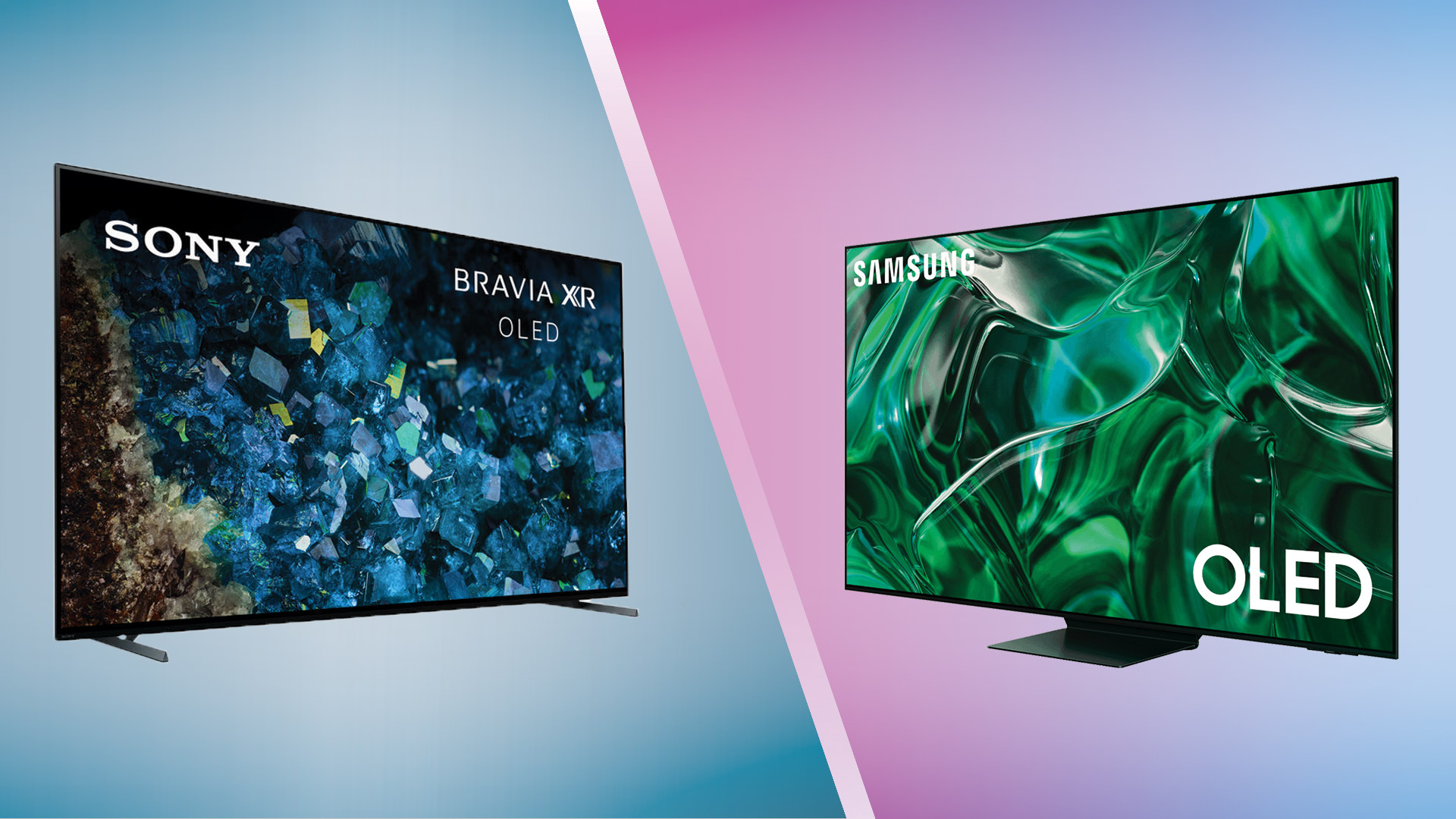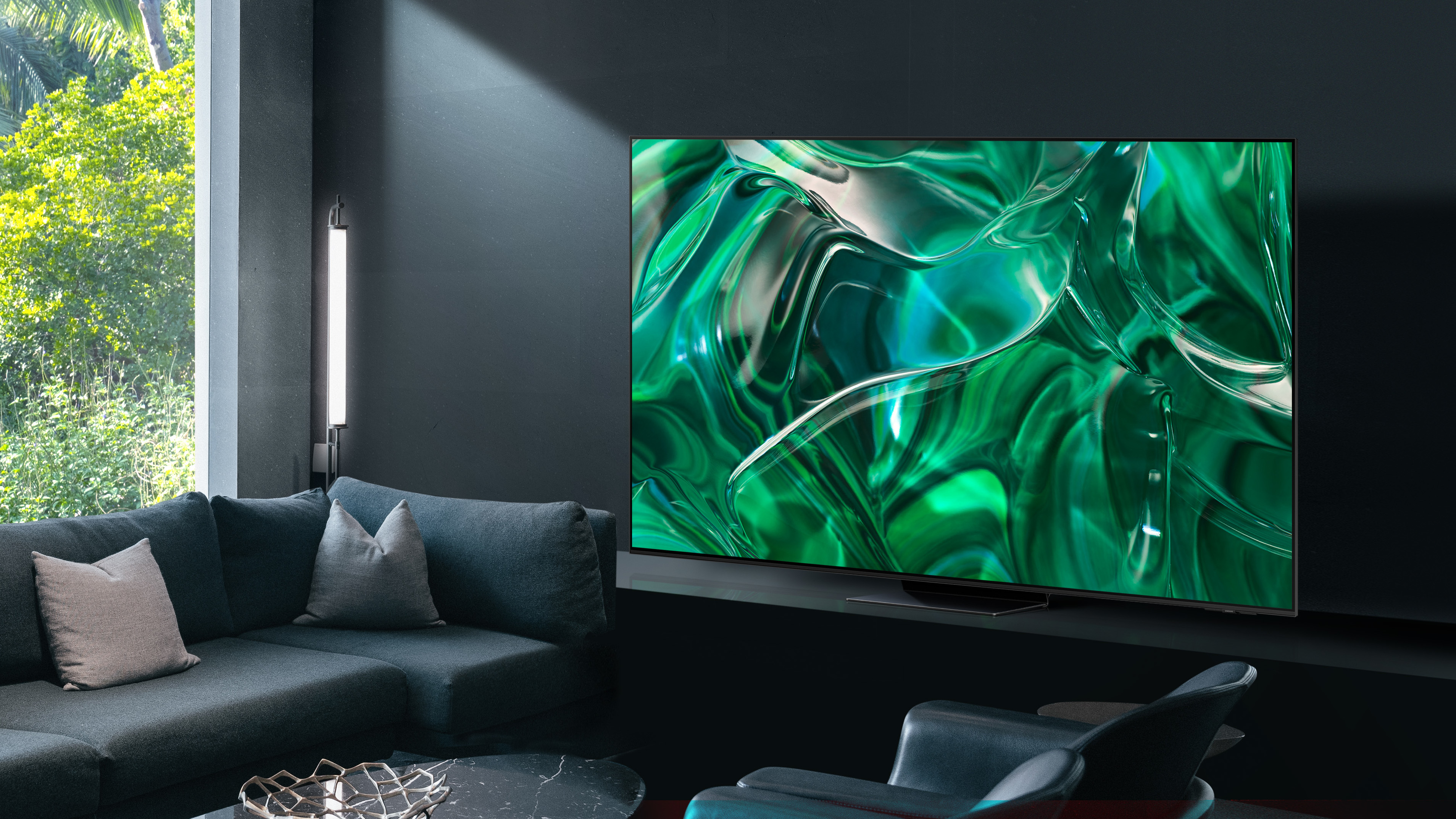
Two of the year's best OLED TVs are battling it out in our Sony A80L vs Samsung S95C comparison, which is here to help you decide which television best suits your needs.
Even if you aren't looking to pick a side, we hope you'll come away from this comparison with a better understanding of what each TV has to offer, and why they should both be considered amongst the best TVs of 2023.
Having spent an extended period of time with both of the televisions in this face-off, we now have a pretty good idea of what each model is capable of in terms of performance, functionality, image quality and audio capability.
So how does Sony's A80L OLED TV compare to Samsung's S95C QD-OLED TV? While both televisions offer beautiful 4K displays that make use of self-lighting pixels, there are a surprising number of differences between the two.
Much like other TVs we've compared against each other, both the Sony A80L and Samsung S95C have their own strengths and weaknesses — the trick is finding out which ones matter most to you.
In this Sony A80L vs Samsung S95C face-off, we'll present you with a rundown of each TV's headline features, as well as their pros and cons, so that you can make an informed decision.
Sony A80L vs Samsung S95C: Price
Before we get into the technology side of things, one of the most important comparisons comes down to how much each TV costs in their available size options.
Sony's A80L 4K OLED TV starts at $1,899 / £2,399 / AU$4,099 for the 55-inch model, before jumping up to $2,599 / £2,999 / AU$5,299 for the 65-inch model, then $3,599 / £4,499 / AU$8,299 for the 77-inch model and $5,499 / £5,499 / AU$12,199 for the largest 83-inch model.
By comparison, the Samsung S95C starts at £2,399 / $2,499 / AU$3,999 for the 55-inch model, followed by the 65-inch model at £3,599 / $3,299 / AU$4,999 and the 77-inch model at £5,099 / $4,499 / AU$7,999.
Given that Samsung's S95C boasts a more advanced QD-OLED panel than Sony's WOLED-sporting A80L, it's perhaps no surprise that the former is slightly more expensive than the latter in the US and UK.
What is surprising, however, is that Sony's recommended retail pricing for the A80L in Australia is significantly more expensive than Samsung's pricing for the S95C, and doesn't really match up to US and UK pricing when directly converted.
Thankfully, the A80L can be found at cheaper prices online (despite being brand new). We've reached out to Sony for more details and will keep you updated.
Sony A80L vs Samsung S95C: Design
Although it's safe to say that both OLEDs sit near the top of their company's TV lineup, neither can be considered a true flagship.
While the S95C is indeed Samsung's top OLED offering of the year, it isn't the South Korean company's most premium TV — that honor goes to the QN900C Neo QLED 8K TV. Likewise, Sony's A80L is beaten out by the Japanese company's QD-OLED offering, the A95L.
From a design standpoint, that translates to a couple of areas where the Sony A80L and Samsung S95C have made slight concessions. For instance, Samsung's S95C lacks the QN900C's near-invisible bezel, while Sony's A80L lacks the A95L's low reflection layer.
Thankfully, both TVs are near-identical to their more premium siblings in terms of connectivity, with the exact same number of HDMI ports all providing identical functionality.
The S95C features Samsung's celebrated One Connect box — a detachable media receiver that holds the S95C's inputs, which are then delivered to the TV through a single all-purpose cable. Here, you have access to four HDMI 2.1 ports, along with the usual USB, RF, Optical and Ethernet inputs.
By comparison, Sony's A80L offers a more traditional experience when it comes to connectivity, with all HDMI ports and inputs located on the TV itself.
Like the S95C, Sony's A80L does support HDMI 2.1, though this is disappointingly limited to just two of the four HDMI ports on offer — and one of those is an eARC port, which you'll probably want to reserve for your soundbar or audio receiver. That means if you have more than one next-gen gaming console, you're going to run into problems getting the desired audio output for every source.
The only real solution here would be to purchase a receiver or soundbar with HDMI 2.1 passthrough (Sony offers two soundbars that qualify in the HT-A5000 and HT-A7000) to give you a bit more wiggle room. Of course, that's an expensive solution and one which shouldn't be needed in the first place.

The two TVs also offer different approaches to their stands. The A80L sports moveable feet that can be placed towards the outer edges of the screen, or about a quarter of the way in on either side — a boon for those who don't own a long TV bench. Meanwhile, the S95C offers the same flat, centered base that's featured on all of Samsung's upper-tier TVs this year, complete with a spot to mount the aforementioned One Connect box.
Another area where the two TVs differ is in the thinness of their panels. Although the screen portion of Sony's A80L is remarkably thin, it has a bulky section on its rear which houses the set's internals and ports. This brings the A80L's overall thickness to 2.08 inches (53mm).
Samsung's S95C sits in stark contrast to that, with a thickness of just 0.4 inches (10.16mm) across its entire panel — a feat it's only able to achieve due to the detached nature of its One Connect box. Because of this, Samsung's S95C is able to deliver a far slimmer profile when wall mounted.
As for each TV's in-built speakers, the A80L sports a 60W 2.2-channel speaker system, while the S95C offers 4.2.2 channels of sound at 70W. While that technically makes Samsung's speaker offering more powerful on paper, Sony's patented Acoustic Surface Audio+ technology essentially turns the A80L's whole screen into one big speaker through vibration, leading to a more impactful sound experience overall.
Sony A80L vs Samsung S95C: Performance
From a processing standpoint, both the Sony A80L and Samsung S95C offer excellent upscaling performance without any noticeable instances of slowdown or image scrambling. You can thank Sony's Cognitive Processor XR and Samsung's Neural Quantum Processor 4K for that.
In terms of picture quality, each model offers the startling levels of clarity and brilliant contrast we've come to expect from 4K OLED televisions. That said, each TV is quite different in its approach to OLED technology, resulting in some key differences when it comes to brightness and color accuracy.
Sony's A80L uses a WOLED (or White OLED) panel — a slightly older technology that emits white light through colored filters in an attempt to boost brightness. Meanwhile, Samsung's S95C uses newer QD-OLED technology which does away with white light, replacing it with an abundance of blue OLED material. This, combined with red and green subpixels and a quantum dot layer, creates a proper white light that's exceptionally bright.
If brightness is one of your main concerns, we can tell you that Samsung's S95C has Sony's A80L thoroughly beat, achieving 1374.3 nits in a 10% window in our peak luminance tests. Meanwhile, Sony's A80L achieved around 600 nits in a 10% window.

Thankfully, the two TVs achieved nearly the same result in terms of color saturation, with HDR content on the A80L covering 99.08% of the UHDA-P3 color gamut, and the S95C reaching 99.18% coverage.
Of course, color accuracy is another matter entirely. In our Delta-E test, where lower numbers are preferred, Sony's A80L had the edge with a measurement of 3.3797, while Samsung's S95C measured 4.0946.
It's worth noting that while Sony's A80L supports Dolby Vision, the S95C does not, opting instead for Samsung's own HDR10+ format. The difference is that Dolby Vision supports 12-bit color depth, while HDR10+ has a 10-bit color depth, making the former technically superior.
As for gaming, both televisions offer a dedicated Game Mode, with support for 4K/120Hz (Samsung's TV also offers 144Hz for PC gamers), along with variable refresh rates (VRR) and auto low-latency mode (ALLM). If you're a PS5 gamer, you'll be happy to know that Sony's A80L will automatically configure the optimal HDR settings for the console, meaning no need to mess with in-game brightness calibration tools.
As for input lag in each TV's Game Mode, we measured 16.3ms on Sony's A80L, while Samsung's faired slightly better with 9.2ms.
Sony A80L vs Samsung S95C: What should you buy?
So which TV should you buy? Both the Sony A80L and Samsung S95C offer brilliantly vivid images and incredible contrast, along with relatively affordable price points for OLED TVs.
As is the case with any new television, each model will have its own strengths and weaknesses, so picking the right one for you will come down to your personal preference.
Of course, there are plenty of differences between the two models in our face-off. Samsung's S95C is definitely superior when it comes to peak brightness, making good use of its advanced QD-OLED technology.
That said, Sony's A80L edges out the S95C when it comes to color saturation and accuracy, leading to a more authentic viewing experience.
However, it's disappointing that Sony's A80L only offers two HDMI 2.1 ports, which will surely lead to complications for AV enthusiasts and next-gen gamers — a problem that won't come up on Samsung's S95C, where all four ports support the HDMI 2.1 spec.
Whether you opt for Sony's A80L or Samsung's S95C, you can rest assured that you'll be getting an excellent OLED TV experience. If brightness and HDMI support are your biggest concerns, we recommend the Samsung S95C. Alternatively, if excellent color reproduction is what you're after, you may want to go with the Sony A80L.
Our in-depth review of Sony's A80L OLED TV is currently in progress, however you can see what we thought about the Samsung S95C QD-OLED right now.







